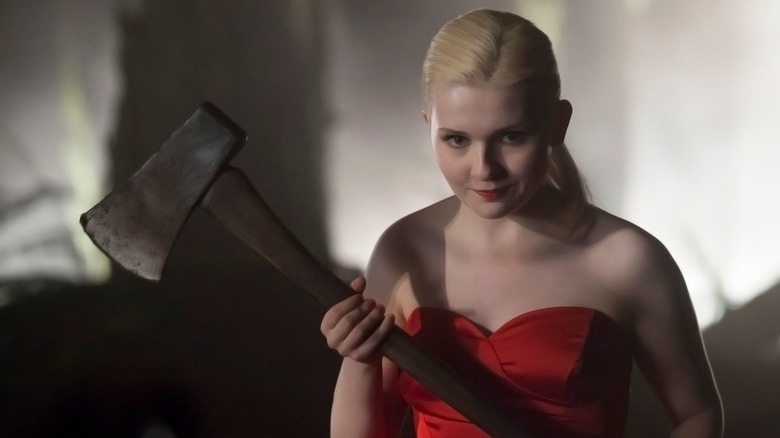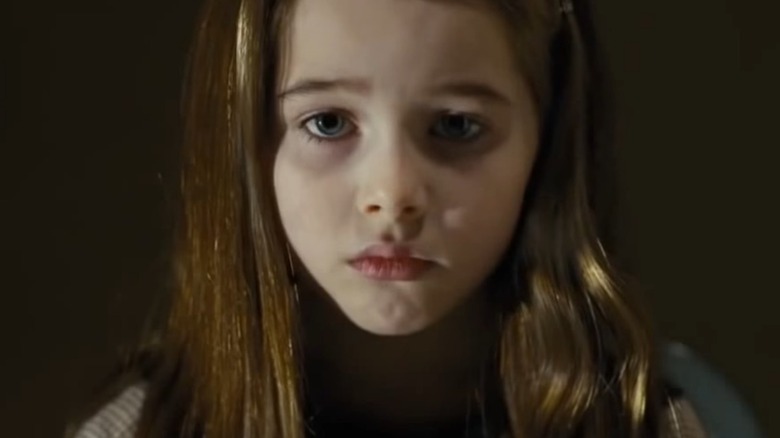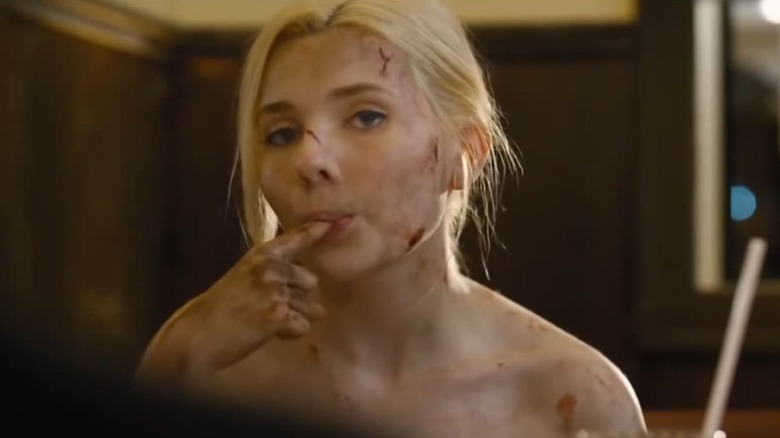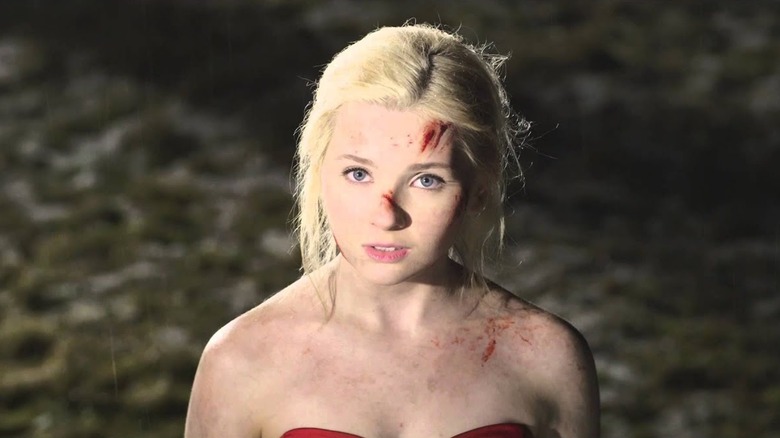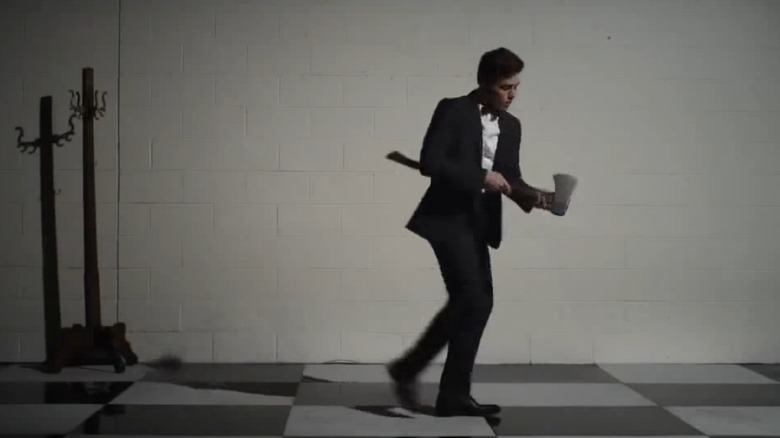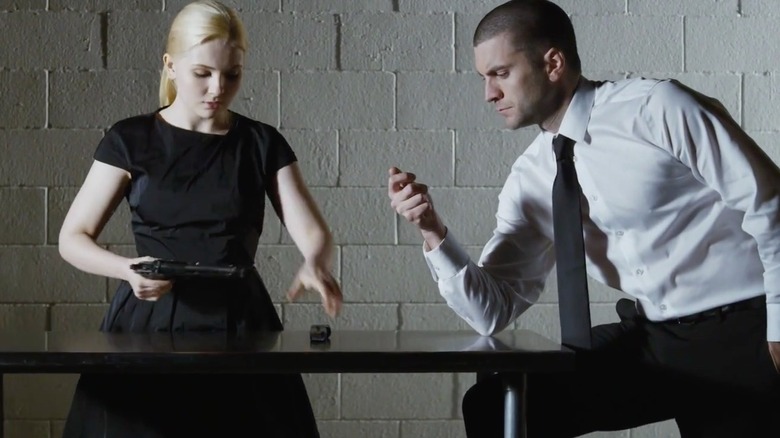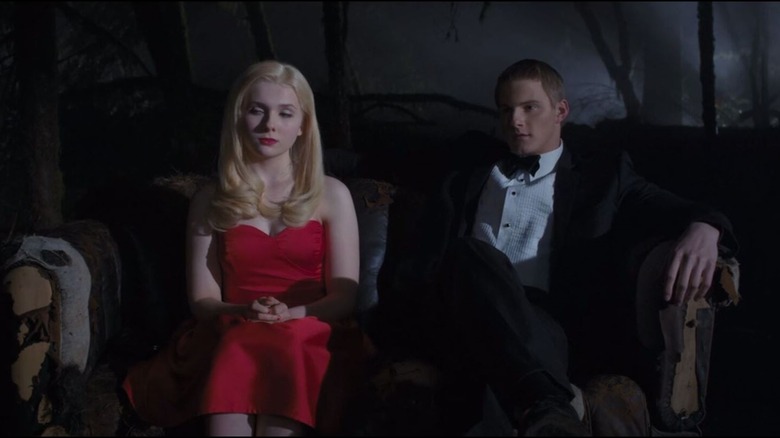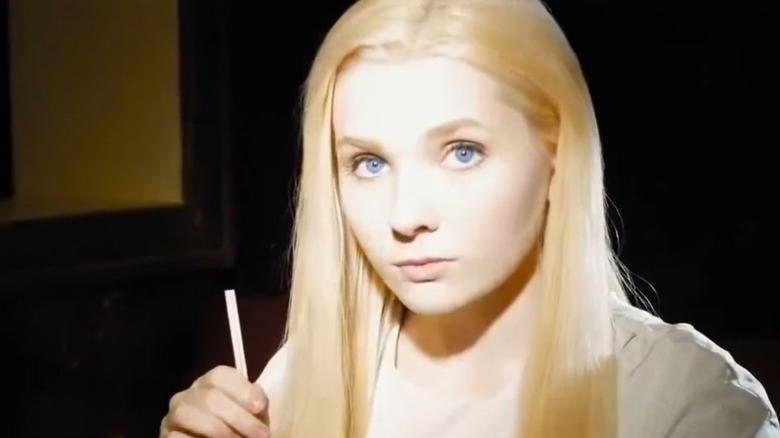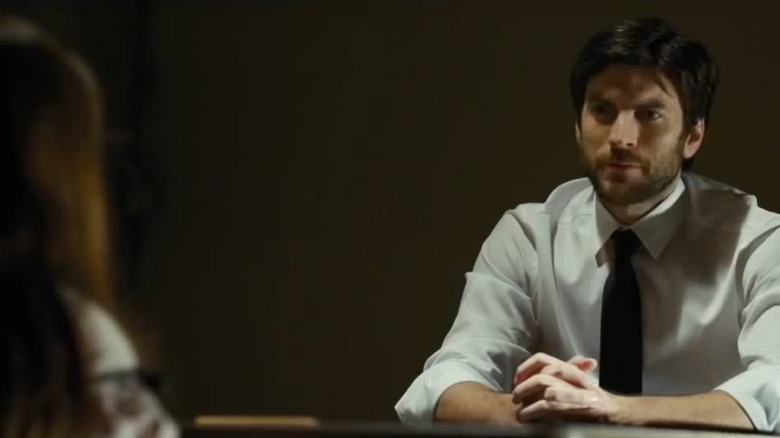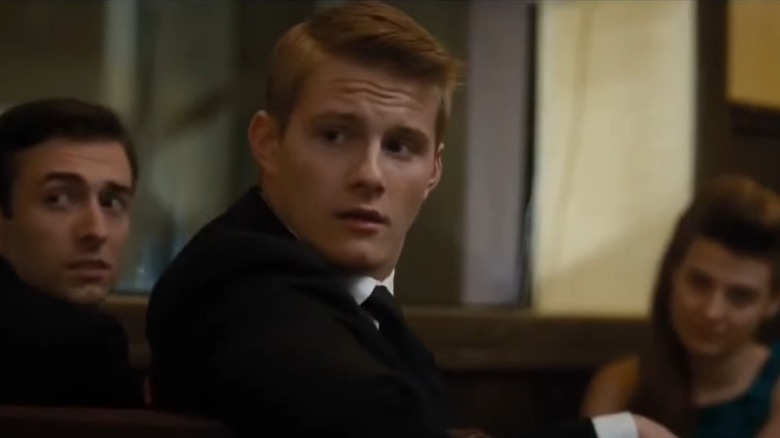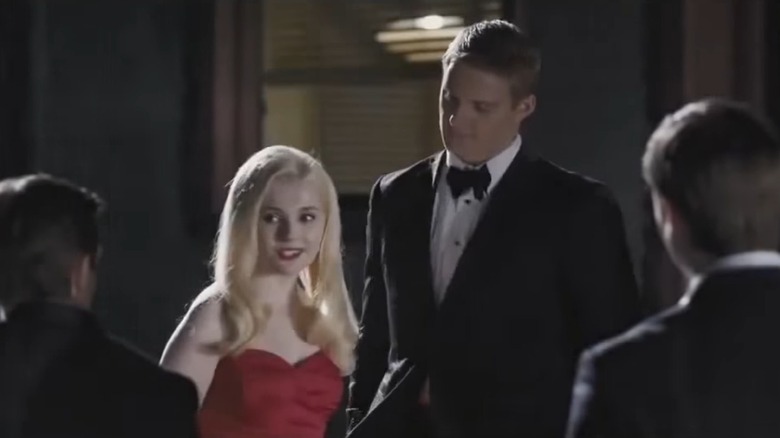The Ending Of Final Girl Explained
What do you get when you mix old school diners, suit-wearing serial killers, and a trained assassin? "Final Girl" dares to ask that question with a fun story about a group of local murderers biting off more than they can chew. Directed by Tyler Shields and starring Abigail Breslin and Wes Bentley, "Final Girl" might not have impressed critics when it debuted in 2015, but it's just unique enough to make for an entertaining evolution of the slasher genre.
Part of what makes "Final Girl" stand out are some bizarre design choices on the part of the director. The movie is set in its own little world where '50s diners still exist and serial killers dress to the nines before hunting their victims. The style harkens back to a time that once inspired golden age slasher movies. It also helps distract from the lingering questions that will pile up in your mind as you make your way through the story.
Are the two main characters part of a secret organization, or are they freelance assassins who are barely more sane than the killers they hunt? What's really going on with everyone's fashion choices? And were those people wearing panda suits? The ending of "Final Girl" doesn't have many answers to offer inquisitive viewers, but we've managed to fill the gaps on its behalf.
What you need to remember about the plot of Final Girl
William (Wes Bentley) is in the business of training killers, and he meets Veronica (Abigail Breslin) shortly after the death of her parents. Veronica catches William's attention because she's still a kid, she's incredibly smart, and, best of all, she doesn't seem to have any emotional reaction to her parents being dead. William spends the next twelve years training Veronica how to be a weapon.
The story really begins just as Veronica's training is about to come to a close. She's learned how to choke, shoot, and otherwise creatively murder all her enemies. She's able to withstand the elements and has even been taught how to keep her cool while under the influence of hallucinogenic drugs. Now all that she needs to do is prove how far she's come by taking on her first solo mission.
William's already scouted out Veronica's targets for her. A group of four boys in a nearby town have been taking girls out to the woods at night and hunting them for sport. William knows that the boys have killed more than a dozen girls, so he has Veronica get close to their ringleader Jameson (Alexander Ludwig). Veronica poses as the group's next victim, and the boys are only too happy to take her out to their hunting grounds. Unfortunately for them, Veronica doesn't plan on being their next thrilling kill.
What happened at the end of Final Girl
When Jameson's band of killers take Veronica out to the woods, she gets to see their habits firsthand. Before revealing their murderous plan, the boys make their victims play an elaborate game of truth or dare. Veronica has to put herself at a disadvantage after being dared to have her hands behind her back, but she also manages to slip drugs into the alcohol the boys drink while they play. She's more than prepared to deal with the horrifying hallucinations the drugs produce, but the boys have no idea what's about to hit them.
One by one the boys have terrifying visions of their worst nightmares, and while they battle the demons in their minds, Veronica picks them off. Eventually only she and Jameson are left alive, but he's thrilled by what she's done. He admits that he's killed twenty girls himself, and he wants to know more about her killing habits, too. He proposes that the two of them work together, roving the country and killing whoever they please. Veronica isn't interested in abandoning William or her training, so she hangs Jameson on a tree in the woods. With her training complete, Veronica and William celebrate with milkshakes at a diner, and then they're off to whatever their next mission might be.
What does the title mean?
Since Veronica is the real star of "Final Girl," it's obvious that she's the titular figure of the movie, but it might be less obvious what that title means. Clearly William has trained killers before, and it seems like he might work for a bigger organization that provides him and Veronica with money. William also presents Veronica's final challenge in a way that makes it seem like people before her have failed their own tests. Maybe Veronica is the final girl that William ever trains, since she passes her tests and goes on to join him in whatever other work he does.
On the other hand, the title "Final Girl" obviously has some significance to the movie's horror genre roots. So many slasher films present a slate of characters ready for the slaughter, and those horror movies have their own final girls. Veronica is a bit like Laurie Strode in that sense. It's also significant that Veronica is the final girl Jameson and his friends ever try to hunt. Jameson is a horror movie villain who won't go on to kill again. Veronica ends his reign of terror on his small town in a pretty permanent way.
What's with the 1950s aesthetic?
You'd expect the highlight of "Final Girl" to be the series of brutal kills that Veronica dishes out during the movie's climax, but you'd be wrong. The most memorable part of the movie is the strangely unreal world it takes place in and all of the design choices that help to create the movie's bizarre reality.
It's impossible to tell exactly when "Final Girl" takes place. Most of the scenes between Veronica and William give us little context about anything at all. They meet in an interrogation room, live in a rundown hotel room, and train in a seemingly abandoned warehouse. If the two of them are part of a larger organization, we never meet the others or learn how they operate. But in the town where Jameson and his friends operate, things are a little different.
Jameson and the rest of the gang meet up at a diner that looks straight out of the 1950s. They order milkshakes while they hit on girls and pick out their next victims. The boys also dress like big-shot singers from decades past. Whenever they go hunting they don suits that wouldn't look out of place on musicians like Frank Sinatra and Sammy Davis Jr. Despite all that evidence, none of the dialogue in the movie comes straight out of the '50s. Instead, it seems that all the costume and set design choices help sell the somewhat off-putting unreality of the movie's world, which makes even more sense when you consider the role that drugs and hallucinations play in the story.
Did William's backstory matter?
The opening scene of "Final Girl" does little to prepare you for the direction the story goes. When William meets Veronica, he tells her a little about himself, and his terse explanation of his backstory sounds exactly like a plot hook. William explains to the little girl that a man killed his family, and that's why he now works as some sort of trainer and recruiter for some sort of shadowy organization.
More than a few viewers had to imagine that "Final Girl" would follow William and Veronica as they got revenge on the man who killed William's family. At least a handful of them probably thought that the movie would explain who William works for or what Veronica is really being trained to do. "Final Girl" bucks all those expectations, and while it does tell the story of the final test in Veronica's training, it never delves any deeper into the questions that get set up in the opening scene.
William's real backstory never got explained in "Final Girl," but that doesn't mean it was unimportant. The brief summary that William gives at the beginning of the movie is really a sly wink to the audience. It says that the bigger story that might exist behind William and Veronica doesn't really matter. "Final Girl" is all about showing us Veronica killing bad guys, and at the end of the day, her reasons for doing so matter much less than the spectacle the movie has to offer.
What was with all the truth or dare?
Veronica learns that before Jameson and his friends go on their killing spree, they make their victims play truth or dare. This isn't an ordinary game, though. The boys have premade dares carved into wooden tiles that are mixed up in a bag. Players pull a dare, and after reading it they can choose truth to avoid doing whatever the tile says. If anyone pulls the same dare a second time, they have to do it. That's how Veronica ends up needing to start the fight with her hands tied behind her back.
By the time the killing begins, everything that happened during the game of truth or dare doesn't really matter. It's true that Veronica managed to turn it into a drinking game to trick the boys into drugging themselves, but she probably could have found another way to do that. The real reason the movie spends so much time on the game is to show just how sadistic Jameson and his friends are.
It's bad enough that Jameson and the others are ruthless killers, but their game of truth and dare shows just how inhumane they've become. Jameson gets to tell a story that sheds some light on why he chooses to kill. The other boys show that they're content to let Jameson take the lead, and how much they enjoy tormenting their victims before they go for the kill.
Did the DMT hallucinations have a deeper meaning?
Veronica goes through intense training over the years she works with William. We see her hike eight miles through the woods barefoot, spar against William, and even learn how to handle a chokehold. But even with all that, there's still one part of Veronica's training that almost takes things too far.
William injects Veronica with a special cocktail of drugs that he created himself. The dose is one-half truth serum and one-half dimethyltriptamine, the incredibly powerful hallucinogenic drug known as DMT. He tells her that the cocktail is designed to make her experience her worst fears. That claim might not have any bearing on reality, but Veronica sees a version of herself getting stabbed to death by William. Once she's built up some tolerance for the cocktail, Veronica uses it against Jameson and his friends.
The hallucinations fulfill the opposite function of the game of truth or dare. They show us that these killers still have some human emotions buried deep within them. Danny, the most unhinged of the group, has visions of men in panda suits chasing him through the woods. Nelson (Reece Thompson) imagines his mother kissing him. Shane (Cameron Bright) begins to think that his longtime girlfriend has been cheating on him with Jameson.
The ringleader himself sees a vision of all his victims marching out of the woods to meet him while he hangs. Jameson doesn't feel any guilt for what he did, but he is afraid that the spirits of his victims will somehow get their revenge.
What will Veronica and William do next?
By the end of the movie, Jameson and his friends are dead. Bloody and battered, Veronica meets up with William, and the two of them go back to the diner for milkshakes. Veronica has completed her professional killer training — but what does that mean for her future?
Presumably, Veronica will now be given other assignments. If her final test is representative of the work that she's going to do in the future, then Veronica might actually be working for some kind of government agency. Who else would have the money to train a child for more than a decade and send her out to kill roving gangs of serial killers? Veronica might spend the next few years working as an assassin before transitioning to William's role and training another girl like herself.
All that might happen, but then again we don't really know that William is working for anyone. It's possible, though less likely, that he's been funding Veronica's training on his own. Maybe this really is a revenge quest, just one that William is willing to take very slowly. Veronica has proven that she can take down groups of killers, without bringing any weapons herself, and while being under the influence of hallucinogens. Whoever killed William's family might be pretty tough, but they probably aren't as tough as Veronica. Now that he has the perfect weapon, William might be able to finally get his revenge.
What has Tyler Shields said about the movie?
Tyler Shields made his directorial debut with "Final Girl." Before working on the movie, he'd only ever directed a music video, but he had already made a name for himself as a photographer. Shields told Eye For Film that even while he was working in photography, he dreamed of getting to make movies. The script for "Final Girl" landed on his lap, and because the producers told Shields he could have almost total creative freedom with the movie, he decided to take it on.
Shields went into the project with a list of changes already in mind. He wanted to somewhat reshape the version of the movie already on the page, and that started with shooting the entire film on location. When it came to creating the look and the feel of the movie, Shields knew that he wanted to lean into the 1950s aesthetic without explicitly setting the movie in the '50s. "The crew joked that we were making a movie set in Tyler time, my own time that I invented," he said. Considering that the film's "Tyler time" setting is one of its standout features, Shields definitely made the right call when he chose to emphasize style over logic in the movie.
Why hasn't there been a sequel?
There's at least a chance that a bigger budget could have transformed "Final Girl" into the start of a franchise. The movie definitely lays the groundwork for a larger story with the hints it drops about William's past. Veronica's entire arc in the film could functionally be the first act in a different story. When "Final Girl" cuts to the credits, it feels like everything is just getting started.
As things played out, "Final Girl" was doomed from the beginning. The movie had a direct-to-video release, so it never even had the opportunity to rake in box office earnings. If it had been released theatrically, there's no guarantee it would have been successful. The movie was blasted by critics, so it's hard to imagine that it would have pulled a huge audience into the theater.
There was a time when a "Final Girl" sequel seemed like it could become a reality. Tyler Shields told Scream, "You know it's funny because when we were shooting the movie one of the producers was like, 'We have got to do a sequel.'" However, that doesn't mean all the world-building elements in the movie were designed as sequel bait. Shields also told Eye For Film, "To me it's all about leaving it as a question for people to wonder about." At the very least, "Final Girl" fans who want a sequel can take some comfort in knowing that the movie's dangling questions were meant to be enticing thought experiments.
